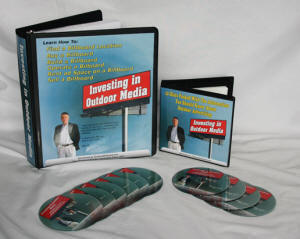Memo From Frank
As Christmas approaches, it’s a great time to think about the New Year and what you want to do different in 2016. For most people, the answer is simple: they want more cash flow. The reasons can vary, from just wanting more money for travel with the family, to wanting to replace their day job or finance their retirement. Regardless of the purpose, there are some great opportunities in the billboard industry. You can get into the business with very little capital, and build a small income stream or an empire, based on how hard you want to work it. There are three American billionaires that began with just one sign: Ted Turner, John Kluge and Artie Moreno. But there are thousands of others who have achieved their financial goals with billboard signs. So if you are starting to think about what you want different in 2016, don’t forget to put billboards on the top of your list for consideration. And Have a Merry Christmas!
All About Lighting: Everything You Need To Know About Billboard Lights
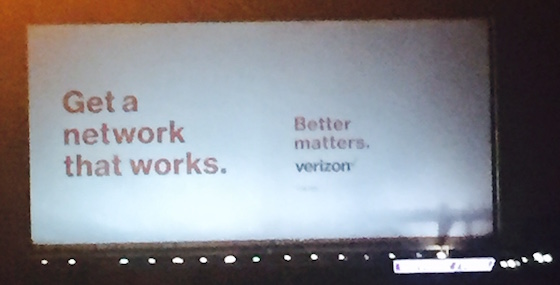
You can’t be in the billboard business without understanding the A to Z of billboard lighting. Since the 1920’s, billboards have been lighted as a standard part of most advertising contracts. But there are many different methods, styles and concepts in lighting signs properly. So let’s jump right into it.
Does the sign even need lights?
Not all billboards are illuminated. So the first question you should always ask is “do I really need to put lights on it?” Of course, the answer in most of America is a definite “yes”. But if you have a sign that is out in the middle of nowhere, is made of wood and telephone poles, and doesn’t rent for a huge amount of money, then it might be possible to go “unlighted”. But the problem is that when you don’t have lights, you limit your advertiser base. Most hotels, restaurants, truck stops, etc. want lights. In addition, if all the other signs on the road have lights, then you really need to keep up with the Jones’.
How do I get the power to the sign?
An important part of making that decision on lights revolves around if there is even the ability to get electrical power to the sign. Sometimes, it’s virtually impossible. I’ve owned signs that would require $50,000 of poles and wires to bring the power over, which was about ten times more than the sign was costing. And don’t be fooled into thinking that just because your sign is on the Interstate that there is power right there for the asking. Power lines often run down one side of the road or the other, and if you’re on the wrong side, you’re looking at a big price tag to “span” the highway with a wire. I once had a sign on I-45 that I could not get power to -- even though the power lines seemed to be right there – because the neighbor would not give me an easement (they hated having a billboard next to their property, and it was their way of protesting the fact).
How bright should they be?
When it comes to figuring out how many and how powerful the lights need to be, the starting spot is what the other signs just down the road are burning. You have to be as bright as the competition, or your sign will be hard to rent or, if you rent it, you will get a constant supply of criticism from the advertiser and no renewal when the lease comes up. You have two basic choices for fixtures: 250 watt and 400 watt. It’s been that way for decades, and the light manufacturers have perfected how to make the light fall evenly on the sign face. One of the pioneer billboard light manufacturers was Crouse-Hinds. But the early fixtures were nothing more than a bulb in a half circle of aluminum with a glass plate over the front. Then came the Halophane, and the world was permanently changed. Their fixture had mirrored reflectors that multiplied the brightness of the bulb, and then a prism lens to disperse the light evenly. Probably the safest way to select your lights is to literally copy exactly what’s on the signs across the street, and the next one up and down from your sign. The key is to blend in and not be the brightest – but also never the dullest.
How many hours a day should they be on?
Most advertisers want the lights to be on from dusk until midnight. That’s when the bulk of traffic goes by the sign. That hits commuters on their way home, as well as travelers before they quit for the night. But there are also advertisers who cater to an all-night crowd, such as hotels and truck stops. And then there are restaurants that are not open all-night, but open later than midnight, such as Taco Bell (normally to about 2 AM). The beauty of the billboard lighting system is that you can custom tailor the lights to go on or off whenever you want. The bad news is that power is expensive, as is the wear-and-tear on your lights, bulbs and ballasts. You have to charge for the amount of power that the customer uses. All-night lighting costs about twice that of dusk until midnight. Remind advertisers that are closed by midnight or earlier that the late night traffic is about 80% truckers and not their key customer base. Nobody ever bought a wedding dress at Sally’s Bridal at 3 AM – unless they’re in Vegas!
How often do I check them?
There is no greater way to destroy your relationship with your advertiser than to have them drive by their billboard only to find the lights are off. They pass that sign maybe a couple times a year, and they will then suspect that the lights aren’t working those other 364 days of the year. You need to make sure that they are working through visual inspection yourself on a regular basis. Today, you can also get this service from satellite technology, but it’s expensive. More than likely, you’ll just need to set about a regular schedule of driving by your signs at night. It’s a good habit, as you’ll also find other things when you drive by, such as the market vacancy, some new advertiser ideas, and storm damage.
Conclusion
Lights are an essential part of most billboards, and you have to understand the basics so that you don’t make any bad decisions when building or buying your sign. I hope this gives you some bright ideas!
The Wrong Way To Market A Vacant Sign
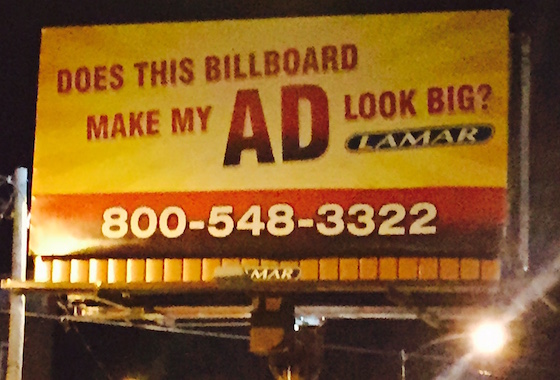
One of the best ways to find an advertiser for a vacant billboard is to put the fact that the billboard is available for rent right up on the sign. However, many people – even giant billboard companies – get the technique completely wrong. Here’s how to do it the right way.
Keep the message simple
Cute messages will not get the job done. Most readers have no idea what the ad message is. Have you seen those messages that say “Gotcha”? Nobody knows what that means, much less that it means that the sign is for rent and to call if you want it. The message needs to simply be: “Sign for Rent”. Those three words convey the entire message in the simplest to grasp way.
Keep the colors in maximum contrast
Without contrast, the copy on a billboard can’t be read. But sometimes the advertiser reduces the contrast for the sake of artistic design. There should be no such limitations here. Use the most contrasting colors available. Based on the study done by the industry in the 1920s, the most contrasting colors are, in order 1) yellow and black 2) white and black 3) red and white. Use these.
Use a background that is the opposite of nature
There is a rule of color law that the eye seeks out the opposite color to the one that it sees in an expanse of similar color. What does that mean? It means that the eye seeks out red (its color opposite) against a sea of green (tree tops). That’s why McDonalds, Arbys, Texaco, Wendy’s – and virtually every other business along the highway – uses red in its signs. You should follow their lead. You “sign for rent” artwork should be based on a red background with white lettering.
Keep the words giant
The bigger the words, the farther back you can read them. In this case, you’ve only got three words and a phone number. So GO BIG. GO REALLY BIG! Make the words the maximum size that you can fit on the sign. There’s no reason to get creative or cutesy. Let the whole world know what the sign is available. Shout it out, don’t whisper it.
Conclusion
If you have a vacant sign, you should definitely put that fact on the ad message and get advertisers calling you to rent it. But do it the right way. Don’t put a cutesy message up there that nobody can figure out. Don’t use small letters or non-contrasting colors. Make the fact bold and simple. That’s what makes the phone really ring.
Billboard Home Study Course
![]() How to Find a Billboard Location
How to Find a Billboard Location
![]() How to Buy a Billboard
How to Buy a Billboard
![]() How to Build a Billboard
How to Build a Billboard
![]() How to Operate a Billboard
How to Operate a Billboard
![]() How to Rent Ad Space on a Billboard
How to Rent Ad Space on a Billboard
![]() How to Sell a Billboard
How to Sell a Billboard
Get Your Copy Now!
Here’s What You Need To Build Your Retirement On
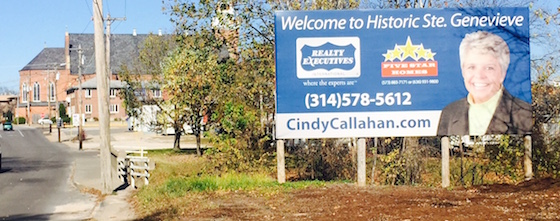
You read articles all the time about what you should do to build a comfortable retirement. Stockbrokers suggest a mixture of stocks and bonds that yield about 3%. That means that you’ll need $1 million in the bank to get $30,000 per year. Travel agents say that you should move to a third-world country, where you can live comfortably on your $1,200 per month social security check – if you consider “comfortable” living in fear of guerillas, having no available medical care, and cowering in a lousy apartment where you don’t know anybody and don’t speak the language. We think, however, the correct way to plan for retirement is with a methodical plan to own billboard signs.
Outstanding economics
Billboards can have the highest yields of any type of real estate endeavor. Let’s just examine the typical billboard stats. Let’s say that you can build a wooden billboard for $4,000. You can rent that sign for $2,000 per year, paid in advance. Once you take out the $800 land rent, taxes, insurance, repair and maintenance and installation of the ad faces, that’s a net income of $2,500 per year. That’s a return on investment of over 60%. And there are many billboards that can do 100%+. Compare that to 3% from your stockbroker – that’s 20 times more per year (the same as 20 years rolled into one). That means that if you built 20 billboards over time (at a total cost of around $80,000), you could have an income of around $50,000 per year for life. And you may find even higher economics on certain wallscapes and other billboard units.
Low up-front cost
You can get in the billboard business for virtually nothing by buying an abandoned, existing sign. Or you can build a sign that’s a wall scape for maybe $2,000. Then there’s wooden signs for $4,000 or less. What’s it all mean? It means that you can get into the billboard business for a fraction of the cost of any other type of investment option. Of course, you could always just build up that million dollar stock portfolio – but is that realistic? Billboards give you a reasonable game plan to create your destiny as you want it.
Recession-resistant
Billboards have a unique feature that is rarely discussed: they are very recession resistant. Most businesses rely on billboards to bring in customers, and will stick with them even when sales are down. Most every advertiser on the highway, for example, must maintain a billboard to capture traffic coming from either direction. On top of that, the internet has dramatically changed the importance of billboards as an advertising tool. While the internet has destroyed newspapers, radio, television – virtually everything – by offering a million content options outside the traditional menu. But billboards don’t have to offer content; you are stuck on the road whether you want to be or not. Commute times are huge and growing. These Americans have no choice but to read billboards out of boredom alone. And advertisers have not lost focus on that.
Only becoming more valuable over time
Billboard rents have been going up annually for as long as such issues have been measured. Many years, they go up 10%. Why? One reason, of course, is that billboards have been hugely helped by the internet to destroy the competition, and to make themselves more valuable. But another reason is that billboards are one of the only industries regulated by the U.S. government. As a result, there is a limited number of legal locations of where a billboard is allowed to go. When you have a finite supply and growing demand, prices rise. This is another reason that billboards are recession-resistant. Once you own a billboard, the values are continually rising, which is a great thing.
Conclusion
Billboards offer the best option for retirement planning and economics. Most Americans have not even heard of this opportunity. Don’t be one of them.
How Did That Sign Get In The Middle Of The Road?
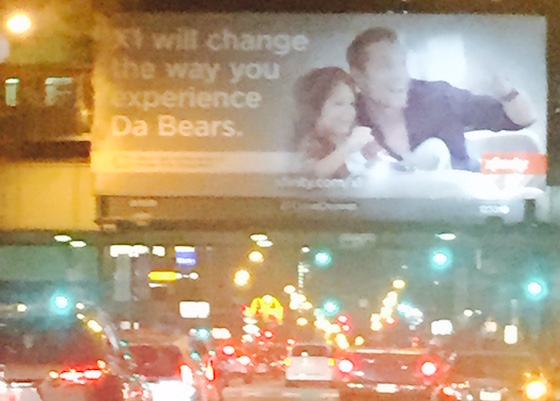
So you’re driving down the road and you see a billboard that’s not on the left or right, but directly in the middle of the street. How did it get there? The answer lies in a strange piece of law and that’s the rules regarding train tracks. When the railroads were built across America, the railroad companies were given some unique rights that nobody else has. One is that the train right-of-way is not subject to the laws of the rest of us. The other is that railroads are the only property owner in the U.S. who own not only both sides of the highway but the span in-between. The reason was that the trains had to do whatever’s necessary to keep the railroad running. But another attribute is that the train tracks are a fertile area for billboards, as they are not bound under the same regulations as the other property owners. Nowhere is this more evident than when a train track goes over a road in New York or Chicago. In those cases, the railroad can build the sign on their easement – even if it’s in the middle of the road. Remember that railroad companies are the #1 landowner for billboards in the U.S., with literally hundreds of thousands of signs on their property. When you see a billboard that’s impossible to build based on your knowledge of the sign laws, it’s a good bet that it relates to the railroads and their special property rights.
New Billboards For Sale On OutdoorBillboard.com
The Market Report
Prices Are Delayed By At Least 15 Minutes
